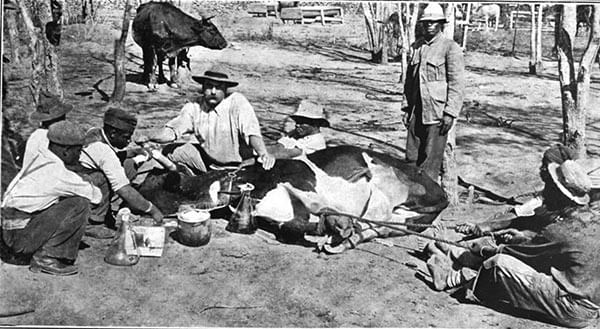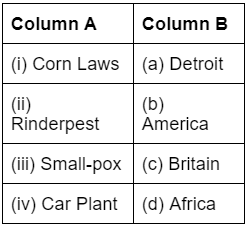The Making of a Global World - 2 Class 10 Worksheet History Chapter 2
Q.1. Describe the impact of ‘Rinderpest’ on people’s livelihoods and local economy in Africa in the 1890s?
OR
How did Rinderpest become instrumental in subjugating the Africans?
OR
Write a note to explain the effects of the coming of Rinderpest to Africa.
Ans. Impact of Rinderpest:
(i) Rinderpest killed 90% of cattle in Africa.
(ii) The loss of cattle destroyed African livelihoods.
(iii) Planters, mine owners, and colonial governments took control of the limited cattle resources to boost their power and force Africans into the labor market.
(iv) Controlling cattle resources helped European colonists conquer and dominate Africa. (Any three)
Q.2. Read the sources given below and answer the questions that follow:
SOURCE A: Silk Routes Link the World [NCERT History Ch. 3 Page 54] The silk routes are a good example of vibrant pre-modern trade and cultural links between distant parts of the world. The name 'silk routes' points to the importance of West-bound Chinese silk cargoes along this route. Historians have identified several silk routes, overland and by sea, knitting together vast regions of Asia, and linking Asia with Europe and northern Africa. They are known to have existed since before the Christian Era and thrived almost till the fifteenth century. But Chinese pottery also travelled the same route, as did textiles and spices from India and Southeast Asia. In return, precious metals – gold and silver – flowed from Europe to Asia.
SOURCE B: Late Nineteenth-Century Colonialism [NCERT History Ch. 3 Page 60] trade flourished and markets expanded in the late nineteenth century. But this was not only a period of expanding trade and increased prosperity. It is important to realize that there was a darker side to this process. In many parts of the world, the expansion of trade and a closer relationship with the world economy also meant a loss of freedoms and livelihoods. Late nineteenth-century European conquests produced many painful economic, social and ecological changes through which the colonized societies were brought into the world economy.
SOURCE C: Rinderpest, or the Cattle Plague [NCERT History Ch. 3 Page 62] In Africa, in the 1890s, a fast-spreading disease of cattle plague or Rinderpest had a terrifying impact on people's livelihoods and the local economy. This is a good example of the widespread European imperial impact on colonized societies. It shows how in this era of conquest, even a disease affecting cattle reshaped the lives and fortunes of thousands of people and their relations with the rest of the world.
Historically, Africa had abundant land and a relatively small population. For centuries, land and livestock sustained African livelihoods, and people rarely worked for a wage. In late nineteenth-century Africa, there were few consumer goods that wages could buy. If you had been an African possessing land and livestock – and there was plenty of both – you too would have seen little reason to work for a wage.
 The Cattle Plague
The Cattle Plague
Questions: SOURCE A: Silk Routes Link the World
(i) Enlist the major items which travelled through the silk routes.
SOURCE B: Late Nineteenth-Century Colonialism
(ii) What was the negative impact of the expansion of trade and a closer relationship with the world economy in many parts of the world?
SOURCE C: Rinderpest, or the Cattle Plague
(iii) In your opinion, why were the Africans not interested in working for wages?
Ans. (i) Chinese pottery, textiles and spices from India and Southeast Asia and precious metals–gold and silver–from Europe to Asia were a few major items which travelled through the silk routes.
(ii) In many parts of the world, the expansion of trade and a closer relationship with the world economy also meant a loss of freedoms and livelihoods. Late nineteenth-century European conquests produced many painful economic, social and ecological changes through which the colonized societies were brought into the world economy.
(iii) Land and livestock were abundant, and the population was less, this was sufficient for the Africans to sustain their livelihood. This, in my opinion, could be a major reason for which they were not interested in working for wages.
Q.3. Critically examine the expansion of trade facilities in the 19th century.
Ans. Expansion of trade facilities in the 19th century:
(i) In many parts of the world, these developments meant loss of freedom and livelihoods.(ii) In the late 19th century, European conquest brought about many destructive economic, social and ecological changes in the colonies.
(iii) In Africa, in the 1890s, a fast spreading disease of cattle plague or Rinderpest had a terrifying impact on people’s livelihoods and the local economy.
(iv) The example of indentured labour migration.
(v) Great misery and poverty for others.
(vi) New forms of coercion in Asia and Africa. (Any five)
Q.4. After the 19th century, how did the indentured labourers discover their own ways of survival? Explain.
Ans.
(i) Initially, indentured laborers struggled with the harsh conditions on the plantations, but they soon found new ways to adapt.
(ii) They created new forms of self-expression, blending old and new art and cultural traditions.
(iii) In Trinidad, the Muharram procession evolved into a lively carnival called ‘Hosay,’ where people of all races and religions participated.
(iv) The protest religion Rastafarianism is believed to have links to Indian migrations to the Caribbean.
(v) Chutney music, popular in Trinidad and Guyana, is another form of creative expression from the post-indentured period.
Q.5. Explain the three types of flows within the international economy in exchanges.
OR
Mention the three types of flows within international economic exchanges during the 19th century.
Ans. (i) Flow of Trade: Trade flow of goods, e.g. cloth or wheat, in which goods are exchanged at long and short distances. For example, Indian weavers produced fine quality cotton cloth and exported it to European countries. But post industrial revolution due to tariff barriers this changed drastically.
(ii) Flow of Labour: The migration of people in search of employment is called ‘Flow of Labour’. Nearly 50 million people emigrated from Europe to America and Australia in the 19th century. All over the world, some 150 million people are estimated to have left their homes, crossed oceans and vast distances over land in search of a better future.
(iii) Flow of Capital Investment for short-term or long-term investment: In this, movement of resources from one country to another takes place through loans or business investments. The British transferred a lot of capital from India to England before independence. All three are closely associated and affected the lives of people in the nineteenth century.
Q.6. What were the ‘Corn Laws’? How was it abolished?
OR
What were the Corn Laws? Why were the Corn Laws abolished? What was the result of the abolishing of Laws?
Ans. (i) The laws allowing the British Government to restrict the import of corn is known as the “Corn Laws”.
(ii) These laws were abolished because the industrialists and urban dwellers were unhappy with high food prices; as a result of which they forced the abolition of the Corn Laws.
Result: Food could be imported into Britain at a much cheaper rate. The immediate effect of the British Government’s decision to abolish the Corn Laws was the inflow of cheaper agricultural crops from America and Australia. Many English farmers left their profession and migrated to towns and cities.
Q.7. Describe three major consequences of the Second World War.
Ans. Major consequences of the Second World War are as follows:
(i) The death toll from the war was enormous, with around 60 million people, or about 3 percent of the world’s 1939 population, believed to have died due to the conflict.
(ii) Millions more were injured, with most deaths occurring outside the battlefield, affecting civilians more than soldiers.
(iii) Large areas of Europe and Asia were devastated, and many cities were destroyed by bombing and artillery attacks.
(iv) The war led to significant economic and social damage, and rebuilding was expected to be long and challenging. (Any three)
Q.8. Explain how the global transfer of disease in the pre-modern world helped in the colonisation of the Americas?
Ans. Global transfer of disease in the pre-modern world helped in the colorization of the Americans:
(i) America was not conquered and colonised by Europeans with the help of superior fire power alone.
(ii) Germs, such as those of smallpox were helpful to a great extent.
(iii) Americans had no immunity against them as a result of long isolation. Once introduced, the germs spread deep into the continent decimating whole communities and paving way for conquest.
Q.9. Mention the two key lessons learnt from the inter-war economic experiences by the economists and politicians after the Second World War.
Ans. The two lessons learnt by the economists and politicians during the Second World War were:
First: An industrial society based on mass production needs mass consumption. For mass consumption, steady income was necessary and for stable income, full employment was necessary. For this, the government has to take steps to minimise the fluctuation of price, production and employment. Hence, economic stability could be ensured by the government intervention.
Second: They understood that international cooperation and economic integration were essential to avoid trade wars and economic conflicts that could lead to global instability.
Q.10. The First World War was a war like no other before. Explain any three features about the war that supports the statement.
Ans. The three features of the war that supports the statements are:
(i) It involved the world’s leading industrial nations.
(ii) This war was the first modern industrial war. Machine guns, tanks, aircraft, chemical weapons, were used on a massive scale.
(iii) Most of those who were killed and aimed were men of working age. The scale of death and destruction was great. These deaths and injuries reduced the workforce.
(iv) Industries during the war were restructured to produce war-related products.
(v) The war led to the snapping of economic links between the world’s largest economic powers which were now fighting with each other to pay for them. The war transformed the US from being an international debtor to an international creditor. (Any three)
Q.11. How did the use of technology transform food availability in Europe?
OR
What was the impact of technology on food availability? Explain with the help of examples.
Ans. (i) Faster railways, lighter wagons and larger ships helped food to reach more cheaply and quickly from faraway farms to markets.
(ii) Earlier the animals were shipped live from America to Europe, many died on the way or became unfit to eat. Thus meat became expensive.
(iii) Refrigerated ships: The animals could be slaughtered at the starting point of America, Australia or New Zealand and transported to Europe as frozen meat.
(iv) This reduced the shipping cost and lowered prices in Europe.
(v) The poor could add variety to their food and it improved their living conditions.
Objective Type Question
Q.12. Match the following:

Ans. (i)-(c), (ii)-(d), (iii)-(b), (iv)-(a)
Q.13. Arrange the following in the correct sequence:
(i) The Second World War
(ii) The Great Depression
(iii) The Chinese Revolution
(iv) The IMF and the World Bank Commenced financial operations
Options:
(a) (i) - (iii) - (iv) - (ii)
(b) (iii) - (iv) - (ii) - (i)
(c) (iv) - (ii) - (i) - (iii)
(d) (ii) - (i) - (iv) - (iii)
Ans. (d)
Q.14. Complete the following table related to resources on the basis of exhaustibility:

Ans. (A) - International Monetary Fund
(B) - International Bank for Reconstruction and Development
Q.15. In Trinidad what was referred to as Hosay?
(a) Annual Muharram procession marking a Carnival.
(b) Christmas celebration
(c) Easter festival
(d) New Year celebration
Ans. (c)
Q.16. Until the 18th century, which two countries were considered the richest in the world?
(a) China and Japan
(b) England and France
(c) India and China
(d) England and Italy
Ans. (b)
Q.17. What is the meaning of ‘cultural fusion’? Give two examples how the indentured labour system led to cultural fusion.
OR
“The indentured labour gave rise to a new culture in the Caribbean islands.” Justify this statement with suitable examples.
Ans. (i) Cultural fusion happens when two or more cultures mix and create a new culture.
(ii) Indentured labourers used to live and work in very harsh conditions. This pushed them to find new ways to relax and find comfort, which led to a mix of different cultural forms.
(iii) Examples:
(a) Hosay: In Trinidad, the annual Muharram procession was transformed into a riotous carnival called ‘Hosay’ in which workers of all races and religions joined.
(b) Chutney Music: ‘Chutney music’ is another creative contemporary expression of the post indentured experience.
(c) Rastafarianism: The protest religion of ‘Rastafarianism’ is also said to reflect social and cultural links with Indian migrants to the Caribbean. (Any two)
Q.18. Describe the social and economic effects of the World War on England and the USA.
Ans. Social Effects:
(i) Most of those killed or injured were working-age people, which impacted the workforce in England.
(ii) Household income declined and women stepped in to take up jobs.
(iii) Role and position of women changed forever in England.
Economic Effects:
(i) Economic links between some of the major economic powers of the world were snapped.
(ii) England borrowed large sums of money from the US Banks.
(iii) USA emerged as an international creditor.
(iv) USA owned more assets in foreign countries than foreign countries owned in the USA. (Any two)
Q.19. ‘China became an attraction destination for investment by foreign MNCs in the 19th and 20th centuries.’ Justify the statement.
Ans. China became an attraction destination for investment by foreign MNCs in the 19th and 20th centuries because:
(i) Wages were relatively low in countries like China.
(ii) This was because of the low cost structure of the Chinese economy, most importantly its low wages.
(iii) TVs, mobile phones and toys were seen in the shops that seem to be made in China.
Q.20. Explain any five factors that led to the Great Depression of 1929.
OR
What do you know about the Great Depression? Write any two causes of it.
Ans. The Great Depression began around 1929 and lasted till the mid 1930s. During this period, most parts of the world experienced decline in production, employment, incomes and trade. Agricultural regions and communities were amongst the most affected.
Causes of Great Depression:
(i) Post-world war economy of the world was fragile. Agricultural overproduction was a problem. As prices slumped, farm produce rotted.
(ii) Many countries financed loans from the US.
(iii) US overseas lenders panicked at the sign of financial crisis.
(iv) Thus, banks were bankrupt and were forced to close down in Europe and in the US because they were unable to recover investments, collect loans and repay depositors.
(v) American capitalists stopped all loans.
|
66 videos|614 docs|79 tests
|
FAQs on The Making of a Global World - 2 Class 10 Worksheet History Chapter 2
| 1. What are the key factors that contributed to the making of a global world? |  |
| 2. How did trade routes influence the development of a global economy? |  |
| 3. What impact did colonialism have on the global world? |  |
| 4. How did the Industrial Revolution contribute to globalization? |  |
| 5. What role did migration play in the making of a global world? |  |





















